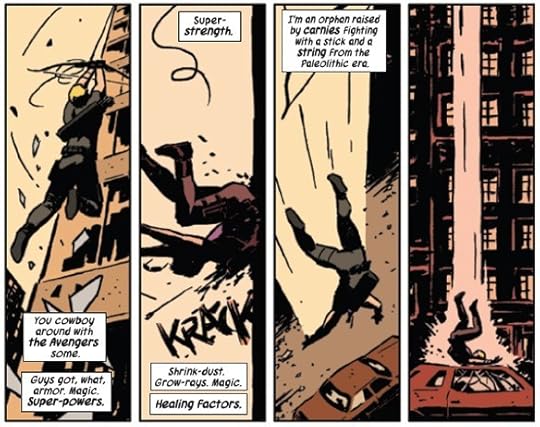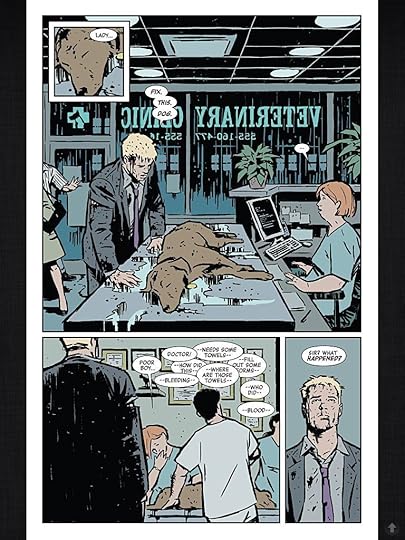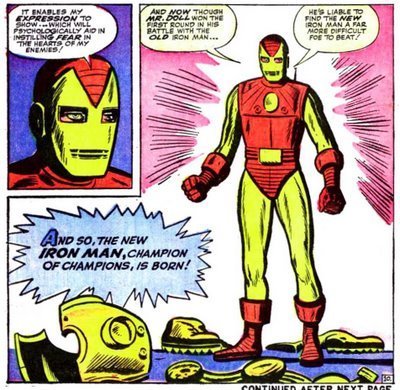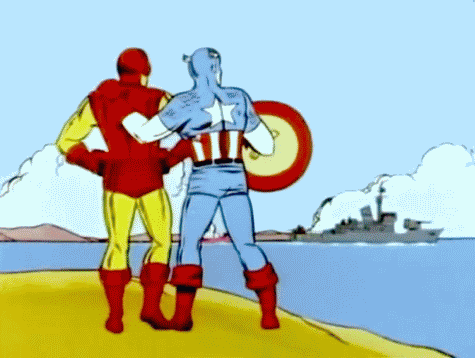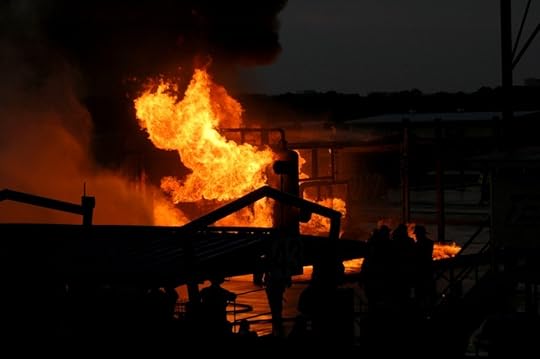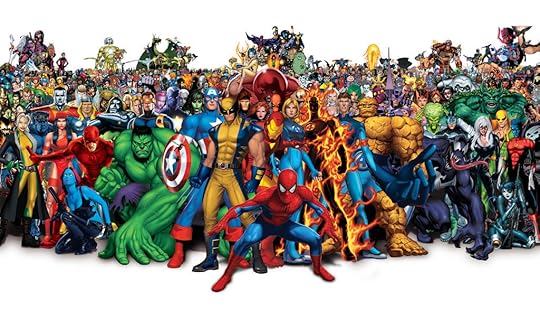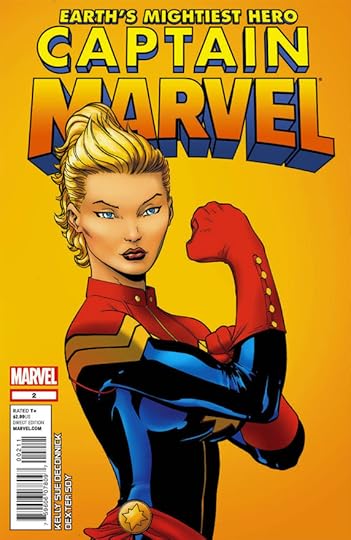Magen Cubed's Blog, page 29
January 14, 2013
Hawkguy: How Clint Barton became a comic book sensation

Interior art from Hawkeye #8 by Annie Wu
A long, long time ago, in the strange world of the 1960s, there was a character named Clint Barton. While he had no superpowers outside of his amazing archery skills, Clint Barton became a superhero under the name Hawkeye. He’s had a lot of adventures in his time, dated a lot of pretty ladies, and took on a lot of other names, like Goliath and Ronin. One time he died and became unstuck in space-time for a while, just chilling between dimensions. He was even in a movie that made a lot of money last summer. (You might have seen it — Robert Downey, Jr. was in it, I think.) Basically, Clint has had a very long and interesting life, but even for that, not a lot of people really knew who he was.
Now? Well, all that’s changed.
Clint Barton has become a very popular character as of late. This is largely due to his ongoing series from Matt Fraction and David Aja. Unlike most other superhero solo books, depicting our favorite heroes on episodic journeys and/or being crushed under their own melodrama, Hawkeye celebrates all that Clint Barton is: Just a guy, who happens to be a hero. Known for its razor-sharp writing and slick design work, the book follows Clint’s very human misadventures in New York City with friend and protege Kate Bishop at his side, as Clint hangs out with his neighbors, fights back against the mob, tries to catch up on his favorite TV shows, and calls Tony Stark to help him put up his Christmas decorations. Nothing is off-limits in this very well-grounded, unheroic title, and it’s refreshing to see. From Clint’s disastrous love-life to the underbelly of the superhero realm, Clint’s world is routinely put under the microscope, explored through stories that never fail to make me want to laugh, or cry, or maybe both.
It’s kind of the best book on the shelves right now. Just saying. You should probably be reading it.
Beyond the smash success of his solo title, Clint also found a bit of fame last year in The Hawkeye Initiative. This made a lot of guys very uncomfortable, much to the amusement of, you know, everybody else. Starting off as a bit of a joke, the website uses “Strong Female Character” Clint to poke fun at the sexist double-standards of the comic book industry. Artists submit “re-imagined” artwork, by depicting him in the same iconic cheesecake poses of many famous female heroes. One part social justice, one part parody, it’s mostly just an excuse for some talented artists to get together and take the piss out of a couple of people that have had it coming for quite a while. Deep down, a part of me thinks Clint just might approve.

Hawkeye by Cassandra James
What it comes down to is, right now? Clint Barton is our through-line into the Marvel Universe, and in a bigger way, our way of talking about the comic book industry in general. He lets us peek into the lives of Marvel’s pantheon of heroes with a dry wit and a palpable sense humanity that’s often lost in big crossover events and episodic adventure stories. He’s kind of like the lens through which we normal folk can evaluate the superhero world, and that’s a pretty cool thing. With the success of The Hawkeye Initiative, he’s even helped fans and artists find a safe space to poke a little fun at the industry, and maybe make a few points along the way.
For a carnie with no powers, I’d say Clint’s done pretty well for himself.
January 13, 2013
Iron Man in the 1960s
We all know that Iron Man is in right now, mostly due to Robert Downey, Jr. and various ongoing children’s cartoons that show what a cool guy Tony Stark is. But does anybody remember what Iron Man used to be like before the LED t-shirts and the Disney purse strings? Oh, yes: It’s the 1960s Iron Man cartoon, with the extension cords and all. Because Batman wasn’t the only one with a kitschy theme song (although I think he was the only one with his own official dance, if that makes a difference), let’s all just take a moment to appreciate that this happened.
You’re welcome.
January 10, 2013
Clara Reyes of The Crashers: Faster than my bullet
When you move this fast, the world has a habit of slowing down for you. Clara doesn’t give it much of a choice.
The room stretches out like spaghetti as Clara moves through it, pulled taut across the planes of her peripheral vision to break down so that she can see the spaces between everything around her. If she concentrates, she’s sure she could see the atoms, the particles, the math that makes up the building’s skeleton and furnishes the apartments. Fire reaches out for her in lapping tongues but doesn’t make it, too slow, too cold to catch up in the wake she leaves behind her. It races through the fibers of the carpets, up the drapes to the ceiling where it swells to eat the room from the top down. There are eight floors in this walk-up, three units to a floor. The entire building will be engulfed in flames within the next three minutes, and there’s still two units between her and the outside wall where Adam and Norah are waiting.
Kyle said that this was a bad idea, but the day she starts putting stock in what Kyle has to say is the day she packs it all in and heads back to Sacramento. Good ideas are for people who have time to weigh their options.
When she reaches the four inches of plaster and wooden frame between this living room and the next, Clara takes a deep breath. Balls her fists, closes her eyes, and punches through. The excess of kinetic energy she’s been storing for the last twenty-seven seconds shields her from the explosion of splinters and nails as she passes through the wall. Debris gets caught up in her field, a slow-motion detonation of furniture and picture frames that disappears as the fire swallows the space behind her. Through a bedroom, a bathroom, a kitchen, she breathes out the smell of burning plastic as she reaches the exterior wall. The brick shatters on impact and she draws herself in, expecting the height and the fall from six floors up.
Falling, falling, falling, the fire behind her and the black sky above, taking wood and metal and glass with her in shards that glitter when she gets up close like this. She doesn’t close her eyes as the ground catches up with her; she couldn’t if she wanted to, the archaic shiver of fight-or-flight putting her feet underneath her and her hands around her ears. The crunch she expects ends in the hard wet packing sound of skin and bone as she and Adam topple over each other to the ground. When time finally catches up with Clara, she’s pressed into Adam’s chest, his arms around her, holding her tightly.
Even with the scraped cheek and the cut above his eye, on his back in the dirt of the street outside, Adam is smiling.
“You’re a show-off, you know that?”
Catching her breath, Clara just shrugs. “I told you to get out of the way.”
January 8, 2013
Horror, demons and more: Publishing news
For all the horror fans among you, do not despair: I haven’t abandoned the genre. In fact, despite my many wanderings in the land of superheroes and comic books, I’m involved in a new anthology coming out this year. From Western Legends Publishing, and edited by author/filmmaker Dean M. Drinkel (who organized both this project and Dark Continent’s Phobophobia), this anthology features 26 stories of various and sundry demonic horror. 26 authors for 26 stories, one for every letter of the alphabet. I’m very excited about this book because it features work from Hellraiser franchise veterans Barbie Wilde and Nicholas Vince, and it’s always good to be in such distinguished company.
As for me, I had the letter O, and wrote a story I called The Debt. It’s about Harvey McHale, an account executive with a secret that brings him to the doorstep of a mysterious nightclub. As always, hilarity ensues — or, you know, something like that.
By Friday afternoon Harvey again found himself outside Black Heaven, sitting in his car, tapping the envelope on the steering wheel. He had already called Scarlett to let her know not to expect him home. She teased him over the phone about tawdry hook-ups with some floozy from Payroll, a strumpet in Sales. Harvey dismissed it with a chuckle, no matter how forced, and tucked his phone into his pocket. A man at the door let Harvey in when he carefully approached, inspecting the extended invite. Tattoos ringed the man’s thick neck, traveling down his arms to his index fingers as he stood in the doorway between slits of red light. With a nod the doorman stepped aside, “Good to see you’ve made it, Mr. McHale.”
Harvey held a breath and tried to smile, walking down the corridor to the staircase at the end. On either side were barred windows into apartments, bedrooms with red walls and ceilings. Inside, people engaged each other in all manners of sex behind curtained silhouettes and half-shut blinds. In one room a collared woman with amputated limbs crawled across the floor like a dog toward a woman waiting on the bed; a man in smeared makeup and a ball-gag bent over the dresser for a slender figure in a full leather suit in the next. It was hard not to stare at them all, sweating and moaning on the other side of the glass. Harvey swallowed thickly and kept his hands to himself, making his way down the staircase. A woman to his left caught his eye, pressed to the window on outstretched palms as a man fucked her roughly from behind. She smiled toothily at him and flicked out a forked tongue, her breath heavy on the window.
The sight made Harvey recoil despite the unwanted arousal coiling in his gut, quickening his steps. At the end of the stairs he walked through a small lobby lined with black armchairs and ornate gold wall fixtures to the host’s stand. There, a hostess in a collared black dress and high ponytail smiled at him.
“Mr. McHale. It’s good to see you.”
“I’m sorry, but what is this?” Harvey asked indignantly. He already regretted his decision to come at all. “How do you know my name?”
“This is Black Heaven,” the hostess smiled, “and Ms. O has been expecting you for a while now.”
“Ms. O?”
“You can follow me to your table now, Mr. McHale.”
He laughed reflexively. “There must be some mistake. I don’t know anybody named O, and I’ve never even heard of this place. She must have me mistaken for somebody else.”
“You can bring that up with her yourself.”
Look for this and other stories of demonic hijinks coming soon both in paperback and online.
January 7, 2013
Adventures in real life
It was a few days after Christmas and I was sitting in a coffee shop on Magnolia Street with a friend from New York. We were talking about the future: Stories we may or may not be writing, relationships that may or may not require pursuit, jobs and colleges and hopes. Trips we need to take and things we need to do, as I tried not to make a big deal about school starting in two weeks. (I’m nervous, so sue me.) It was cold outside, getting colder as the sun set behind the Fort Worth skyline peeking out from behind little shops and old lamp posts. Talking about the future always makes me depressed, so I try to avoid it. I like to make my plans, but I prefer to keep them close to the vest. It’s nobody’s fault; it’s just how I’m wired. My friend and I exchanged hugs at the train station and promised to keep in touch.
A week later it was Saturday night, after three weeks of long shifts and the stress of holiday business. I was sitting on the patio of a bar downtown with my brother and a friend, nursing a few dark beers to keep the chill off. I hadn’t seen this friend in two years, after a brief but highly eventful relationship with the aforementioned brother. Sitting there, cold even under two jackets, it was like picking up where we left off two years ago, as if nothing ever happened. Like standing around the patio outside of the restaurant we were working at the time, sipping beers and talking about kung fu movies and cartoons, comic books and British television.
Another beer, and a shot or three, and it was like nothing had ever changed.
“I miss this,” she finally said, plucking the thought right out of my brain. “I miss just hanging out like this. Going back to your place, drinking, talking. Everybody we worked with wanted in on this, you know, back then.”
I sort-of laughed at that. “That’s because they weren’t fun.”
“No, I’m serious,” my friend continued. “You’re just — so much fun. You, your family? It’s amazing what you guys have, the way you guys are. You may not always think it, but you’ve got it so good.”
Maybe, after all was said and done, she was right.
A lot of things happened before I went home. Run-ins at other bars, an embarrassing foray into hip-hop night on Houston Street, work-related melodrama. My friend and I exchanged numbers — the same numbers we had two years ago, which I didn’t realize until I got home — and promised to call and text and make plans. We’re grown-ups, after all, and it’s been long enough. The past is the past and I’m over the things the did and didn’t happen, things both spoken and left unsaid. And it felt good.
My past and my future met just a week apart, in little bars and coffee shops in Fort Worth. I can’t tell if I’m moving forward or backward now, but at least I’m not standing still.
January 2, 2013
Comic book review: New Avengers #1
In a book full of lofty ideas and cosmic danger, Black Panther – the lone holdout of the original Illuminati – must assemble the group of men he no longer trusts to save the world from the threat of colliding universes. From Jonathan Hickman and Steve Epting.
The issue opens on a flashback to the day Black Panther left the Illuminati, setting the opening chapter up with a somber forewarning from Reed Richards: Everything, everywhere, eventually dies. A mysterious alien force has come to Wakanda, bringing with them an army as they lay siege across the spectrum of parallel realities. Not unlike its sister book Avengers, this title kicks off with the beginnings of a very large, reality-spanning arc, pitting Black Panther against an imposing group of otherworldly beings. After they kill three young Wakandan scientists, he fights them off until they retreat back through their portal, disappearing to regroup. Begrudgingly, Black Panther puts out the call – bringing in Iron Man, Mister Fantastic, Doctor Strange, Black Bolt, Namor and Captain America – and assembles their forces in the coming war.
There’s a lot to like about this book: Hickman sets up a big, fairly cerebral story with some interesting villains at the center. I really enjoy T’Challa’s narration and the gravity of the writing, getting some good dramatic use out of the concept of these brilliant, powerful, and arrogant men coming together to do battle. Epting’s pencils are spot-on throughout, with some lovely design work and very cinematic pacing. On the downside, the book moves a bit slowly, and the front-end is loaded with dialogue and disposable characters. This window-dressing bogs things down a bit, but as an introduction, it’s still solid and engaging. As the spotlight moves from T’Challa to the rest of the team, I’m hopeful to see the pace pick up.
Comic book review: Iron Man #5
The opening arc of Believe comes to a close in this issue, as Tony Stark debuts his new suit and looks toward the future. This issue is low-key and the suit is a bit strange, but I have few complaints over all.
Faced with an ever-changing world on his path to self-realization, Tony sets off to retrieve Extremis from old friend Eli aboard an orbiting space station. Like everyone else who had procured the Extremis kits, using them to (in some way) better themselves or others, Eli wanted to use Extremis to upgrade humanity for living space. His intentions are noble, but Tony still makes the judgment call to steal Extremis back to keep it from falling into the wrong hands. This poses a poignant question for Tony, who begins to wonder what he would do if he were in Eli’s shoes: How he would change the world if he could do things differently, and what kind of legacy he would leave behind when he did.
Like the rest of the Believe arc, this issue is full of quiet reflection for Tony as he works to decide what kind of man he wants to be going into the future. Gillen has written a small, episodic story about who Tony was, who he is now, and who he can be if he puts his mind to it. There are no great overtures here; just a series of interesting little adventures that help Tony progress as a human being. I enjoy that about Gillen’s Iron Man: The character, from his expanding armor of suits to his new AI, feels like he’s growing, even in a format aimed toward casual readers rather than the dedicated fanbase.
This arc, for all its bumps and stumbles along the way, does set the stage for the title moving forward and for the stories coming around the bend. It’s not perfect, and it’s not a major must-read for Iron Man fans, but at the end of the day it’s been an enjoyable ride. Even with Land’s pencils, I might add, which I’m not going to bring up again because I sound like a broken record already. The suits are lovely as always, and I’ll just leave it at that.
For all of my complaining about this book, this final chapter, in its own way, put it into perspective for me. This is a book about the future, and this was just how Gillen got us there in the transition from Fraction’s run. It’s not as grand or ground-breaking as promised, but moving forward, I’m hoping Gillen’s able to use the stage he’s built to tell bigger stories. With the next issue hyping the consequences of killing the Phoenix Force in Avengers vs. X-Men, I’m optimistic about where this book is going.
December 31, 2012
2012: The obligatory retrospective
By most accounts, 2012, you were a piece of crap. I spent most of you sick, or depressed, or some combination of the two. You went by very quickly and it felt like you didn’t give me much chance to get anything useful done. You didn’t even end in the fiery ball of shit and chaos you promised with this whole Mayan calendar thing. Basically, 2012? You were kind of a dick. I’m not very sad to see you go, but if I’m honest, a few decent things did come out of you.
That week I spent in New York City.
My panel with the guys from Post-Mortem Press at Texas Nightmare Weekend .
The Marilyn Manson and Rob Zombie Twins of Evil concert on Halloween.
Enrolling in college for spring.
Getting into comic book blogging.
The Xenomorphs art show.
Dallas Comic Con and Dallas Fan Days .
Working on story about demonic nightclubs for this upcoming anthology.
Plotting the four books of my upcoming novel series.
Other things happened, too, of course. Gallery openings and impromptu photo shoots, lunches with friends and little misadventures in good old Fort Worthless. Maybe you weren’t so horrible, 2012, but I’m glad you’re gone. Tell your little friend 2013 over there to watch his step. I’m not having any of his shenanigans this year.
December 26, 2012
Comics: A Year in Review
2012 was a big year for Marvel Comics, from the smash success of Avengers to the launch of Marvel NOW. It was a pretty big year for me, too, taking on comic book blogging and reviewing full-time. As some of you know, beyond blogging and reviewing for my own site, I also do weekly reviews for Marvel DISASSEMBLED. It’s been a good experience so far, although I’ve only been at this since the summer, and it’s gotten me a lot of feedback from the creative and editorial staffs over at Marvel.
Now that 2012 is drawing to a close, I’d like to leave you all with my personal list of the best books of the year.
Hawkeye
I have only one thing to say: Believe the hype. From Matt Fraction and artists David Aja and Javier Pullido, this book is almost too good to be true. Funny, clever, and action-packed, this title grounds the drama and flair of the superhero world with Clint Barton’s very real, very fallible humanity. Every issue is whip-smart and gorgeous to look at, with Aja’s and Pullido’s art serving to deftly complement Fraction’s quietly heroic stories of an every day guy in a world far bigger than he can control.
Captain Marvel
Helmed by Kelly Sue DeConnick and Dexter Soy, this book is for fans who love their superhero stories with a strong sense of heart. Issue after issue the writing only gets better, striking a perfect balance of action/adventure and personal drama as Carol first struggles with her new mantle before coming to thrive. With sharp dialogue and great character development, this is a consistently enjoyable book that only gets better with time.
Captain America
From Rick Remender and John Romita, Jr., this book shows us a Captain America we’ve never seen before: Trapped in the hellish wasteland of Dimension Z, Steve has only his wits and his training to keep him and the young boy Ian alive against vicious mutates and marauders. This title takes time to try to build up exactly who Steve Rogers is, where he comes from, and who he chooses to be moving forward. While I’m not the biggest fan of Romita’s artwork, Remender’s fresh and novel vision of Captain America makes this a book worth checking out.
Avengers
Sweeping and operatic, this book from Jonathan Hickman and Jerome Opena promises to be the start of the biggest Avengers story ever told — and so far, it’s lived up to the hype. Everything about this title is big, from the villains to the heroes to the intergalactic scope, without losing sight of the characters that drive the action. Opena’s art is absolutely stellar, both heroic and poised, creating a lush stage for Hickman’s stories to play out on. Out of all the books I’ve read this year, this is the one I’m most looking forward to in 2013.
Uncanny Avengers
From Rick Remender and Joe Cassaday, this book is a surprisingly interesting and well-balanced new chapter in the future of hero/mutant relations. Red Skull, now armed with Charles Xavier’s brain, is the most threateningly we’ve ever seen him, committed to exterminating mutants in his Eternal Reich. It makes for a fairly clever and original story, as Captain America tries to strengthen the Avengers’ relationship with mutantkind by recruiting a reluctant Havoc for a mutant branch of the team after the events of Avengers v. X-Men. As the flagship title of the Marvel NOW line, this book is still finding its footing, but the more cerebral approach Remender is going for makes me very hopeful for its future.
FF
From Matt Fraction and Mike Allred, this book is like the quirky little sister to its sibling title Fantastic Four, and it works. Weird and funny, with some genuine moments of humanity amid the bright colors and attacking giants, this title is just an off-beat, enjoyable read.
December 20, 2012
How I learned to love reconstruction
I have two favorite books, out of many favorite books, that hold the top two spots in no particular order. I quote them constantly, especially at bars, when my sobriety is in question. My sobriety so hotly debated, in fact, that I have even threatened on more than one occasion to get various passages tattooed upon my person, up to and including my ass. These books are Watchmen by Alan Moore and Fight Club by Chuck Palahniuk. I know, I know — what an original and forward-thinker I must be to align my world view with two of the most popular works of fiction of the last thirty years. What a genius that I, between the ages of 18 and 24, held these works in such high regard as the greatest in deconstructionist literature. All of that said, this has nothing to do with the books, although they have greatly influenced everything I’ve ever written — in any genre, with any theme, and for any reason — for the last decade. Really, the books themselves are fine. It’s the deconstruction part that kind of bugs me these days.
I want to talk about reconstruction instead.
Okay, yeah, we all go through our deconstructionist phase. I’ve spent enough time in the classroom, pouring over film and literature, art and performance, looking at the best, most precise ways to tear things apart. That’s what art is, right? It’s the act of rendering something down — a concept, a memory, a feeling — to its basest, most human parts and putting it on a page, canvas or film strip for others to ingest, analyze, and file away. We’re all taught a great deal on the act of destroying a thought or a principle. We’re all taught to look at things and to rip them to shreds, finding the faults and the holes in comfortable stories and settings until we’re blue in the face. You and me, we know what’s up, right? It’s safe to say that we can critique our way out of numerous paper bags. As a society, I think, we’re pretty on-point in destroying things. I’d say we’re even pretty good at it.
Any savvy consumer of media can tell you what’s wrong with something when it’s put in front of their face, and that’s a great thing. It is absolutely critical to being an objective patron in the flashy, fast-moving world of big budgets, corporate interest and SEO terms. You have to know what you’re being sold, what’s wrong with it, and how to dismantle it if necessary. But the older I get, and the more I learn about fiction and narrative, concept and realism, the less I find myself preoccupied with deconstruction. And somehow, yes, this circles back around to superheroes, and I’ll explain why in a minute.
Let’s take Watchmen for example, since I brought up superheroes. This book is a huge and completely blatant rip on everything wrong in the superhero genre. It takes a huge dump on all of our favorite archetypes, showing the flaws and the fallacies in the pie-eyed escapism the genre perpetuates, where readers allow self-appointed heroes make the moral decisions for all of us and quietly sweep the consequences under the rug. Because the kinds of people who would put on masks and run around in the dark must be off their tits, right? They have personality disorders and violent tendencies and delusions of grandeur. They would have to — what else would possess a man to put on tights and fight crime?
My 18-to-24 year old self, very disillusioned with the kinds of stories being told in mainstream comics, and the childish fantasies of grown men being paraded around to excuse their (frankly gross and upsetting) behavior, ate it up with a spoon. It took the piss out of everything I was mad about and twenty-five years later, still stood up as the final nail in the coffin of my love affair with superhero comics. It was what I needed at the time. I think anybody who reads the genre understands that.
Then, you know, things changed.
By 25, when I got back in the genre as a reviewer rather than just a reader, I had a calmer head. Leaning on my education and experience as a writer, I could be a much more savvy consumer. I was able to look at this genre objectively, to spot the major flaws as well as the tiny triumphs, and to address them appropriately. I could look back on Watchmen and celebrate that it was the story that needed to be told at the time, but not the only story that matters moving forward.
While industry standards still dictated a certain level of gross behavior, writers and artists were winning small battles in the effort to elevate the genre with deeply personal stories and character arcs. Kelly Sue DeConnick on Captain Marvel is a good example of that, as well as Matt Fraction’s Hawkeye; Kieron Gillen’s Tony Stark in Iron Man and Kathryn Immomen’s take on Sif in Journey into Mystery show that character-driven stories still work in larger, action-heavy contexts. No, it’s not perfect, but it’s getting better than where it was when I left. I’d learned to stop being so reactionary, and, instead of just pointing out problems and setting fires, to offer solutions and compromises. It doesn’t have to be love or hate, admiration or destruction. You can love something with all your heart (like, you know, Captain America, for example) while still knowing all its flaws, and find ways to portray it better in the future.
This is why it comes back to comics and superheroes. Wanting to write comics was how I got into writing in the first place, an embarrassingly long time before those rocky 18-to-24 years, when I was writing so many flaming critiques to Marvel Comics that they started sending them back unopened. (It’s still a highlight for me. Just saying. I like to bring it up at parties.) These days I can only hang out on the periphery, writing reviews for mainstream books and putting together weird indie comics whenever I can, trying to solve problems in very small ways.
I’m tired of taking things apart; you can only do it for so long before it wears you down. That’s why I’m taking on the projects that I am, and tackling superhero fiction. I don’t just want to talk about the problems that I have with it, because I do have quite a few. (Unbalanced representation of women, minorities, the disabled, the LGBT-aligned, etc.; endless runs that change creative teams with no resolution, end goal or continuity; sloppy, trend-based writing and artwork; I could go on for a while). I want to talk about solutions, too, and ways to do better by the genre. Hell, I just want to put it all on the table, and make my inner thirteen-year-old’s dreams come true. I want to do it all.
So, when people ask me why my next book is about superheroes, I want to tell them that it’s because I’ve taken a lot of things apart. I want to try putting them back together for a change.

